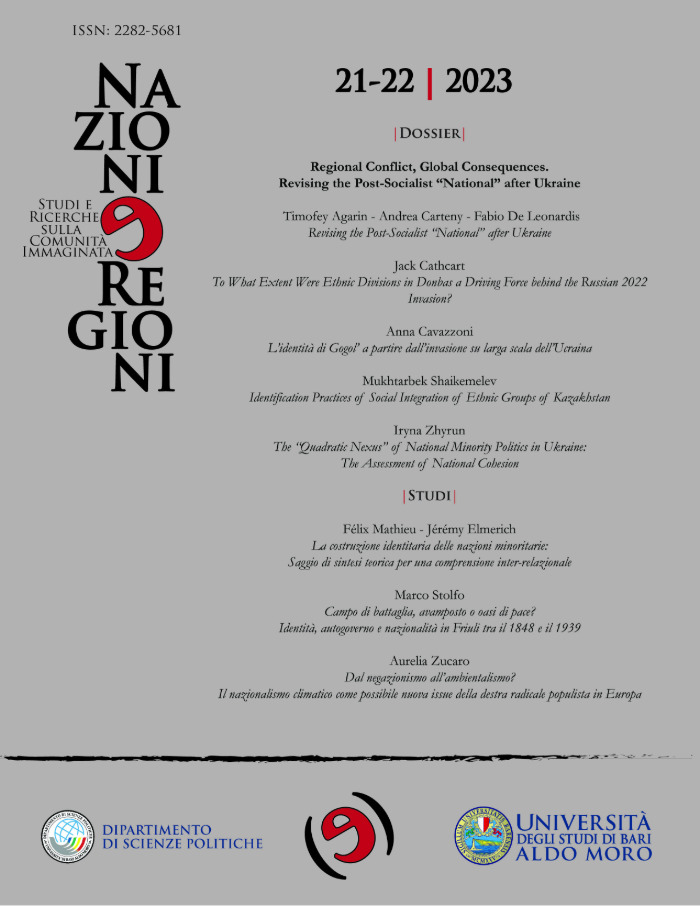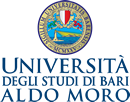To what extent were ethnic divisions in Donbas a driving force behind the russian 2022 invasion? <br> <br> In che misura le divisioni etniche nel Donbas hanno dato impulso all’invasione russa del 2022?
DOI:
https://doi.org/10.15162/2282-5681/1930Parole chiave:
Donbas, Russian nationalism, Ukraine, Russian Federation, ethno-nationalism, nazionalismo russo, Ucraina, Federazione Russa, etnonazionalismoAbstract
On the 11th May 2014, the self-proclaimed “People’s Republics” of Donetsk and Luhansk, which had emerged in opposition to the Maidan revolution which ousted President Viktor Yanukovych, would hold referendums on the issue of independence from the state of Ukraine. These referendums, which were considered illegal by the Ukrainian government, were subsequently followed by eight years of conflict in the Donbas region, leading up to the February 2022 full scale Russian invasion. This research will seek to examine how the Russian Federation, as a state actor, co-opted and reframed economic and social problems that resulted from the failure of the state-building process in Donbas since 2014, presenting them as ethno-nationalist grievances, in order to establish a pretext for the 2022 invasion. The research will include an exploration of the history of the Donbas region and reactions to Ukrainian independence, polling before and after the Maidan revolution in the occupied regions until 2020, and the economic and social problems (specifically citizenship and voting) that emerged after the stalling of the Novorossiya project. The article will then compare these real world events with statements from the Russian media, examining how grievances were consistently framed as a national issue, whilst pushing the narrative that ethnic Russians and Russophones were under threat in Donbas.
L’11 maggio 2014 le autoproclamate “Repubbliche Popolari” di Donec’k e Luhans’k, sorte in opposizione alla rivoluzione del Majdan che aveva rovesciato il presidente Viktor Janukovič, tennero dei referendum sulla questione dell’indipendenza dallo Stato ucraino. A questi referendum, considerati illegali dal governo ucraino, seguirono poi otto anni di conflitto nella regione del Donbas, culminati nel febbraio 2022 in un’invasione su vasta scala da parte della Federazione Russa. Questa ricerca tenterà di esaminare il modo in cui la Federazione Russa come attore statale ha cooptato e ridefinito i problemi economici e sociali risultanti dal fallimento del processo di costruzione statale avviatosi nel Donbass dal 2014, presentandoli come rimostranze etnonazionaliste onde avere un pretesto per l’invasione del 2022. La ricerca comprenderà anche un’esplorazione della storia della regione del Donbas e le reazioni all’indipendenza ucraina, i sondaggi nelle regioni occupate prima e dopo la rivoluzione del Majdan fino al 2020, e i problemi economici e sociali (in particolare la cittadinanza e il voto) emersi dopo lo stallo del progetto della Novorossija. L’articolo inoltre metterà a confronto questi eventi del mondo reale con le dichiarazioni dei media russi, esaminando il modo in cui le rimostranze venivano sistematicamente ridefinite come una questione nazionale, al tempo stesso portando avanti la narrazione secondo la quale nel Donbas i russi e i russofoni erano in pericolo.
Riferimenti bibliografici
Allan D. (2020), «The Minsk Conundrum: Western Policy and Russia’s War in Eastern Ukraine», Chatham House, 22-V, https://www.chathamhouse.org/2020/05/minsk-conundrum-western-policy-and-russias-war-eastern-ukraine-0/minsk-2-agreement (last visit 20-XII-2023).
Barrington L. (2022), «A New Look at Region, Language, Ethnicity and Civic National Identity in Ukraine», Europe-Asia Studies, 74 (3), p. 365.
Brown D. (2004), «Why Independence? The Instrumental and Ideological Dimensions of Nationalism», International Journal of Comparative Sociology, 45 (3-4), pp. 277-296.
Burkhardt F. - Rabinovych M. - Wittke C. - Bescotti E. (2022), Passportization, Diminished Citizenship Rights, and the Donbas Vote in Russia’s 2021 Duma Elections, Harvard University Press, Cambridge MA.
Cavandoli S. (2016), «The Unresolved Dilemma of Self-Determination: Crimea, Donetsk and Luhansk», International Journal of Human Rights, 20 (7), pp. 875-892.
Coynash H. (2021), «Russia’s Lie Machine Fans Flames of Odessa ‘Massacre’», CEPA, 30-IV,
https://cepa.org/article/russias-lie-machine-fans-flames-of-odessa-massacre/ (last visit 20-XII-2023).
Dougherty J. (2014), Everyone Lies: The Ukraine Conflict and Russia’s Media Transformation, Harvard Kennedy School, Cambridge MA.
Driscoll J. - Arel D. (2023), Ukraine’s Unnamed War, Cambridge University Press, Cambridge.
Düben B. A. (2020), «“There is no Ukraine”: Fact-Checking the Kremlin’s Version of Ukrainian History», 1-VII, https://blogs.lse.ac.uk/lseih/2020/07/01/there-is-no-ukraine-fact-checking-the-kremlins-version-of-ukrainian-history/ (last visit 20-XII-2023).
Dudko O. (2022), «A Conceptual Limbo of Genocide: Russian Rhetoric, Mass Atrocities in Ukraine, and the Current Definition’s Limits», Canadian Slavonic Papers, 64 (2-3), pp. 133-145.
Duvold K. - Sunvisson K. (2015), «Beyond Borders: The Return of Kin-State Politics in Europe», Baltic Worlds, 1 (2), pp. 19-32.
Epuryanu V. (2022), «Gde my byli 8 let. Kak otvechat’ na propagandu Kremlya o voyne», The Insider, 21-III, https://theins.ru/antifake/249459 (last visit 20-XII-2023).
Fedor J. (2015), «Introduction: Russian Media and the War in Ukraine», Journal of Soviet and Post-Soviet Politics and Society, 1 (1), pp. 1-12.
Flynn M. K. (1996), «Political Mobilization in Eastern Ukraine: The Referendum of 1994 in the Donetsk Oblast», The European Legacy, 1 (1), pp. 342-349.
Friedgut T. H. (1994), «Perestroika in the Provinces», in Friedgut T. H. - Hahn J. W. (eds.), Local Power and Post-Soviet Politics, Routledge, London.
Friedgut T. H. - Siegelbaum L. (1990), «The Soviet Miners’ Strike July 1989: Perestroika From Below», The Carl Beck Papers in Russian and Eastern European Studies, no. 804.
Giuliano E. (2018) «Who Supported Separatism in Donbas? Ethnicity and Popular Opinion at the Start of the Ukraine Crisis», Post-Soviet Affairs, 34 (2-3), pp. 158-178.
Halperin C. J. (2006), «Rus’, Russia and National Identity», Canadian Slavonic Papers / Revue Canadienne Des Slavistes, 48 (1/2), p. 158.
Hosaka S. (2019), «Welcome to Surkov’s Theatre: Russian Political Technology in the Donbas War», Nationalities Papers, 47 (5), pp. 750-773.
Hrytsak Y. (1998), «National Identities in Post-Soviet Ukraine: The Case of Lviv and Donetsk», Harvard Ukrainian Studies, 22 (1), p. 263.
Ishchenko V. (2016), «Far Right Participation in the Ukrainian Maidan Protests: An Attempt of Systematic Estimation», European Politics and Society, 17 (4), pp. 453-472.
Jones D. A. (2020), «The “Fascist” and the “Potato Beetle” – Patriotic Chronotypes and Dehumanizing Language in Wartime Ukraine», American Ethnologist, 50 (1), pp. 30-42.
Kochanev A. (2020), Requiem for Donbas: Three Essays on the Costs of War in Ukraine, Johannes Kepler University, Linz.
Kolstø P. (2022), Strategic Uses of Nationalism and Ethnic Conflict: Interest and Identity in Russia and the Post-Soviet Space, Edinburgh University Press, Edinburgh.
Kulyk V. (2016), «National Identity in Ukraine: Impact of Euromaidan and the War», Europe-Asia Studies, 68 (4), pp. 588-608.
Kuromiya H. (1998), Freedom and Terror in the Donbas: A Ukrainian-Russian Borderland, 1870s–1990s, Cambridge University Press, Cambridge.
Kursani S. (2023), «Beyond Putin’s Analogies: The Genocide Debate on Ukraine and the Balkan Analogy Worth Noting», Journal of Genocide Research, vol. 25, nos. 3-4, pp. 371-383,
DOI: 10.1080/14623528.2022.2099633
Kuzio T. (1998), Ukraine: State and Nation Building, Routledge, London.
Kuzio T. (2001) «Identity and Nation-Building in Ukraine: Defining the Other», Ethnicities, 1 (3), p. 347.
Kuzio T. (2005), «From Kuchma to Yushchenko Ukraine’s 2004 Presidential Elections and the Orange Revolution», Problems of Post-Communism, 52 (2), pp. 29-44.
KIIS - Kyiv International Institute of Sociology (2014), «The Views and Opinions of South-Eastern Regions Residents of Ukraine», KIIS, April,
https://www.kiis.com.ua/?lang=eng&cat=reports&id=302&page=1&y=2014&m=4 (last visit 20-XII-2023).
Laruelle M. (2016), «The Three Colors of Novorossiya, or the Russian Nationalist Mythmaking of the Ukrainian Crisis», Post Soviet Affairs, 32 (1), pp. 55-74.
Levada Centre (2023), «Conflict With Ukraine: Assessment for March 2023», Levada Centre, https://www.levada.ru/en/2023/04/07/conflict-with-ukraine-assessments-for-march-2023/ (last visit 20-XII-2023).
Matveeva A. (2022), «Donbas: the Post-Soviet Conflict That Changed Europe», European Politics and Society, 23 (3), pp. 410-441.
Mejias U. A. - Vokuev N. E. (2017), «Disinformation and the Media: The Case of Russia and Ukraine», Media, Culture and Society, 39 (7), pp. 1027-1042.
Miklasová J. (2022), «Russia’s Recognition of the DPR and LPR as Illegal Acts Under International Law», Völkerrechtsblog, 24-II, https://voelkerrechtsblog.org/russias-recognition-of-the-dpr-and-lpr-as-illegal-acts-under-international-law/ (last visit 20-XII-2023).
Milakovsky B. (2018), «Cut Off: What Does the Economic Blockade of the Separatist Territories Mean for Ukraine?», Wilson Center, 9-I, https://www.wilsoncenter.org/blog-post/cut-what-does-the-economic-blockade-the-separatist-territories-mean-for-ukraine (last visit 20-XII-2023).
Marandici I. - Lesanu A. (2021), «The Political Economy of the Post-Soviet De Facto States: A Paired Comparison of Transnistria and the Donetsk People’s Republic», Problems of Post-Communism, 68 (4), pp. 339-351.
Munsch А. - Liebig О. (2011), Identity and Conflict in Crimea. Exclavisation Tendencies, Russian Memory and Ukrainian Statehood on the Margins of Europe, University of Geissen, Geissen
Onuch O. (2014), «The Maidan and Beyond: Who Were the Protesters?», Journal of Democracy, 25 (3), pp. 44-51.
Osipian Ar. L. - Osipian Al. L. (2006), «Why Donbass Votes for Yanukovych: Confronting the Ukrainian Orange Revolution», Demokratizatsiya: The Journal of Post-Soviet Democratization, 14 (4), pp. 495-517.
Paul C. - Matthews M. (2016), The Russian “Firehose of Falsehood” Propaganda Model: Why It Might Work and Options to Counter It, RAND Corporation, Santa Monica CA.
Polovyan A. V. - Lepa R. N. - Grinevskaya S. N. (2022), «The Donbass Economy: State, Development Trends, and Forecasts», Studies on Russian Economic Development, 33 (2), pp. 163-168, https://www.ncbi.nlm.nih.gov/pmc/articles/PMC8976567/ (last visit 20-XII-2023).
Putin V. V. (2021), «On the Historical Unity of Russians and Ukrainians», 12-VII, http://en.kremlin.ru/events/president/news/66181 (last visit 20-XII-2023).
Riabchuk M. (2023), «Invented ‘Europeanness’ Versus Residual Slavophilism: Ukraine as an Ideological Battlefield», in Suslov M. et al. (eds), Pan-Slavism and Slavophilia in Contemporary Central and Eastern Europe, Palgrave Macmillan, London.
Sasse G. (2019), «Attitudes and Identities across the Donbas Front Line: What Has Changed from 2016 to 2019?», ZOIS, 27-VIII, https://www.zois-berlin.de/publikationen/attitudes-and-identities-across-the-donbas-front-line-what-has-changed-from-2016-to-2019 (last visit 20-XII-2023).
Saideman S. M. - Ayres R. W. (2008), For Kin or Country: Xenophobia, Nationalism, and War, Columbia University Press, New York.
Shekhovtsov A. - Umland A. (2014), «The Maidan and Beyond: Ukraine’s Radical Right», Journal of Democracy, 25 (3), pp. 58-63.
Shevsky D. (2022), «Euromaidan Revolution in Ukraine», in Goldstone J. A. - Grinin L. - Korotaev A. (eds.), Handbook of Revolutions in the 21st Century, Springer, New York- Cham, pp. 851-863.
Shulman S. (2010), «The Contours of Civic and Ethnic National Identification in Ukraine», Europe-Asia Studies, 56 (1), p. 1.
Skorkin K. (2023), «What the Return of Kremlin Ally Medvedchuk Means for the War in Ukraine», Carnegie Endowment for International Peace, 20-I, https://carnegieendowment.org/politika/88849 (last visit 20-XII-2023).
Smeltz D. - Sullivan E. - Wojtowicz L. - Volkov D. - Goncharov S. (2022), Russian Public Accepts Putin’s Spin on Ukraine Conflict, Chicago Council on Global Affairs and Levada Centre, Chicago.
Stebelsky I. (2018), «A Tale of Two Regions: Geopolitics, Identities, Narratives, and Conflict in Kharkiv and the Donbas», Eurasian Geography and Economics, 59 (1), pp. 28-50.
Suny R. (2022), «A Historian Corrects Misunderstandings about Ukrainian and Russian History», The Conversation, https://theconversation.com/a-historian-corrects-misunderstandings-about-ukrainian-and-russian-history-177697 (last visit 20-XII-2023).
Suslov M. (2017), «The Production of ‘Novorossiya’: A Territorial Brand in Public Debates», Europe-Asia Studies, 69 (2), pp. 195-377.
United Nations Human Rights Commission (UNHCR) (2023) «Ukraine Refugee Situation»,
https://data2.unhcr.org/en/situations/ukraine (last visit 20-XII-2023).
United Nations Human Rights Monitoring Mission in Ukraine (HRMMU) (2022) «Conflict-related Civilian Casualties in Ukraine», United Nations Human Rights Council, Geneva.
Verkhovna Rada (2023), «To the 15th Anniversary of the All-Ukrainian Referendum. Documents from the Funds of the TsDAVO of Ukraine», http://www.archives.gov.ua/Sections/15r-V_Ref/index.php?11 (last visit 1-VII-2023).
Vice News (2014), «Anger Over Odessa Reaches Donetsk: Russian Roulette in Ukraine», Dispatch 34,
https://www.youtube.com/watch?v=1BSSocdQor8 (last visit 20-XII-2023).
Vice News (2014a) «Donetsk Demands a Referendum: Russian Roulette»,
https://www.youtube.com/watch?v=wetleAB1XmY (last visit 20-XII-2023).
Vikhrov M. - Butchenko M. (2016), «The Phenomenon of the “People’s Republics” of Donbas», Carnegie Endowment for International Peace, https://carnegie.ru/2016/04/12/ru-pub-63295 (last visit 20-XII-2023).
Warsaw Institute (2021), «What Is Behind Russia’s Passportization of Donbas?», Warsaw Institute,
https://warsawinstitute.org/behind-russias-passportization-donbas/ (last visit 20-XII-2023).
Wimmer A. - Cederman L. E. - Min B. (2009), «Ethnic Politics and Armed Conflict. A Configurational Analysis of a New Global Dataset», American Sociological Review, 74 (2), pp. 1-25
Wimmer, A. (2013), Waves of War, Cambridge University Press, Cambridge.
Wynn C. (2014), Workers, Strikes, and Pogroms: The Donbass-Dnepr Bend in Late Imperial Russia, 1870-1905, Princeton University Press, Princeton NJ.
Downloads
Pubblicato
Fascicolo
Sezione
Licenza
Nazioni e regioni è una rivista open access che applica la licenza Creative Commons CC BY-NC-ND 4.0 a tutti i contenuti pubblicati.
Nazioni e regioni is an open-access journal that applies the Creative Commons CC BY-NC-ND 4.0 licence to all published contents.







